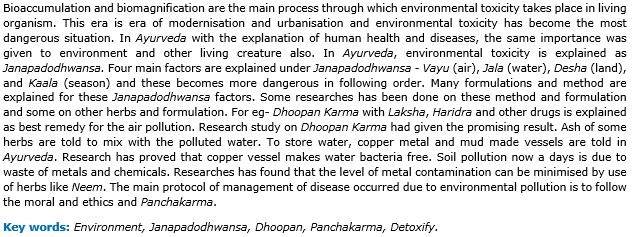Environmental toxicity: prevention & cure in Ayurevda
DOI:
https://doi.org/10.21760/jaims.8.6.12Keywords:
Environment, Janapadodhwansa, Dhoopan, Panchakarma, Detoxify.Abstract
Bioaccumulation and biomagnification are the main process through which environmental toxicity takes place in living organism. This era is era of modernisation and urbanisation and environmental toxicity has become the most dangerous situation. In Ayurveda with the explanation of human health and diseases, the same importance was given to environment and other living creature also. In Ayurveda, environmental toxicity is explained as Janapadodhwansa. Four main factors are explained under Janapadodhwansa - Vayu (air), Jala (water), Desha (land), and Kaala (season) and these becomes more dangerous in following order. Many formulations and method are explained for these Janapadodhwansa factors. Some researches has been done on these method and formulation and some on other herbs and formulation. For eg- Dhoopan Karma with Laksha, Haridra and other drugs is explained as best remedy for the air pollution. Research study on Dhoopan Karma had given the promising result. Ash of some herbs are told to mix with the polluted water. To store water, copper metal and mud made vessels are told in Ayurveda. Research has proved that copper vessel makes water bacteria free. Soil pollution now a days is due to waste of metals and chemicals. Researches has found that the level of metal contamination can be minimised by use of herbs like Neem. The main protocol of management of disease occurred due to environmental pollution is to follow the moral and ethics and Panchakarma.
Downloads
References
Resmi BG, Yadav CR, Abhilash M. Impact of environmental toxicity on health in ayurvedic parlance. Int J Community Med Public Health 2022;9:3326-34
Yadav et al., An ayurvedic review on janapadodhwamsa, Innovare Journol of Ayurvedic Science, Vol 9, Issue 6, 2021, 1-5
Sharma RK, Das VB. Charaka Samhita by Agnivesa, Vimanasthana, Chapter 3: Janapadhodhwamsaneeyam Vimanam, Verse (1)6, Chaukhambha Sanskrit Series Office, Varanasi, India, Reprint. 2008;142.
Celine C, Sindhu A, Muraleedharn MP. Microbial growth inhibition by aparajitha dhooma choornam. Anc Sci Life. 2007;26(3):4-8.
Kulkarni KA, Zambare MS. Impact of house plant in the purification of environment using wireless sensor network. Scientific Res Open Access. 2018;10(3):59- 69.
Sharma PK, et al, Agnihotra – a non-conventional solution to air pollution. Int J Innovative Res Sci Amp Eng. 2014;2.
Sudha VB, Ganesan S, Pazhani GP, Ramamurthy T, Nair GB, Venkatasubramanian P. Storing drinkingwater in copper pots kills contaminating diarrhoeagenic bacteria. J Health Popul Nutr. 2012;30(1):17-21
Harikumar PS, Manjusha CM. Study on the Antibacterial activity of selected Natural Herbs and its application in Water Treatment. Drinking water Engineering and Science Discussions. 2013;6:199- 231.
Acharya VJT. Susruta, Sushruta Samhita, Kalpasthana, Chapter 3: Jangamavishakalpa Vijnaneeya, Verse 10-11, Chaukhambha Sanskrit Samsthan, Varanasi, India. 2014;568.
Acharya VJT. Charaka Samhita by Agnivesa, Vimanasthana Chapter 3 Janapadhodhwamsaneeyam Vimanam, Verse (3) 6, Chaukhambha Prakashan, Varanasi, India. 2007;241.
Saktivel V, Vivekanandan M. Springer Reclamation of tannery polluted soil for phytoremediation. Physio Mol Biol Plants. 2009;15(2):175-80
Rege NN et al., Adaptogenic Properties of Six Rasayanaa Herbs Used in Ayurvedic Medicine. Phytotherapy Research Phytother Res. 1999;13:275-91.
Singh N et al., An overview on ashwagandha: a Rasayanaa (rejuvenator) of Ayurveda. Afr J Tradit Complement Altern Med. 2011;8(5):208-13.















